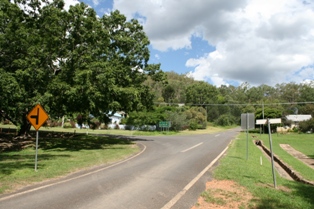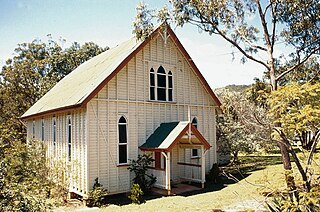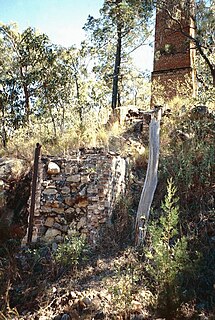
Irvinebank is a town and locality in the Shire of Mareeba, Queensland, Australia.

St Matthew's Anglican Church is a heritage-listed church at Beatrice Street, Drayton, once a town but now a suburb of Toowoomba in Toowoomba Region, Queensland, Australia. It was designed by James Marks and built from 1886 to 1887 by Seath, Hobart and Watson. It is also known as St Matthew's Church of England and is the second church of that name in Drayton. It was added to the Queensland Heritage Register on 21 October 1992.

St Agnes Anglican Church is a heritage-listed churchyard at Ipswich Street, Esk, Somerset Region, Queensland, Australia. It was designed by John Hingeston Buckeridge and built in 1889 by Lars Andersen. It is also known as St Agnes Rectory and Church Hall. It was added to the Queensland Heritage Register on 21 October 1992.

St Matthews Anglican Church is a heritage-listed church and cemetery at 35 Church Road, Mitchelton, City of Brisbane, Queensland, Australia. It was designed by Charles Tiffin and built from 1867 to 1869 by Mr Mahoney. It is also known as Grovely Church, as it is within the Parish of Grovely. It was added to the Queensland Heritage Register on 21 October 1992.

Holy Trinity Church is a heritage-listed Anglican church at 141 Brookes Street, Fortitude Valley, City of Brisbane, Queensland, Australia. It is the second church on that site. It was designed by Francis Drummond Greville Stanley built from 1876 to 1877 by James Robinson. It was modified in 1920-1921, 1925 and 1929. It was added to the Queensland Heritage Register on 21 October 1992.

St Paul's Anglican Church is a heritage-listed church at 124 Brisbane Street, Ipswich, City of Ipswich, Queensland, Australia. It was built from 1855 to 1929. It was added to the Queensland Heritage Register on 21 October 1992.

St Peter's Anglican Church and Hall is a heritage-listed church at 85 Elm Street, Barcaldine, Barcaldine Region, Queensland, Australia. It was designed by Edwin Hockings and built in 1899. It was added to the Queensland Heritage Register on 21 October 1992.

St Mark's Anglican Church is a heritage-listed church at 36 Larnach Street, Allenstown, Rockhampton, Rockhampton Region, Queensland, Australia. It was built in 1900. It was added to the Queensland Heritage Register on 28 July 2000.

St John's Anglican Church is a heritage-listed church at 278 Ford Street, Berserker, Rockhampton, Rockhampton Region, Queensland, Australia. It was built in 1912. It was added to the Queensland Heritage Register on 5 August 2003.

Christ Church Anglican Church is a heritage-listed church at Cannon Street, St Lawrence, Isaac Region, Queensland, Australia. It was designed by Alfred Mowbray Hutton and built in 1898 by Newman Brothers. It was added to the Queensland Heritage Register on 27 October 2000.

St Saviour's Anglican Church is a heritage-listed former church building at 26 Hynes Street, South Johnstone, Cassowary Coast Region, Queensland, Australia. It was built from 1938 to 1939 by Mose Romano. It was added to the Queensland Heritage Register on 24 September 2004.

St David's Anglican Church is a heritage-listed church at 3 Foxton Avenue, Mossman, Shire of Douglas, Queensland, Australia. It was designed by Edward Taffs and Edwin Roy Orchard. It was added to the Queensland Heritage Register on 6 August 2010.
Eyre & Munro was an architectural partnership in Townsville, Queensland, Australia. A number of their works are now heritage-listed.

Herberton Uniting Church is a heritage-listed church at 2-4 Lillian Street, Herberton, Tablelands Region, Queensland, Australia. It was built in 1891 by R Petersens. It is also known as Herberton Presbyterian Church. It was added to the Queensland Heritage Register on 27 August 1999.

Coolgarra Battery is a heritage-listed stamper battery at Coolgarra Station, Silver Valley, Tablelands Region, Queensland, Australia. It was built from 1896 to 1901. It is also known as Coolgarra Old Furnace. It was added to the Queensland Heritage Register on 25 August 2000.

St Marks Anglican Church is a heritage-listed church at 7 Eacham Road, Yungaburra, Tablelands Region, Queensland, Australia. It was built in 1912. It is also known as St Marks Church of England. It was added to the Queensland Heritage Register on 21 October 1992.

St Patrick's Catholic Church is a heritage-listed church at 1 Penda Street, Yungaburra, Tablelands Region, Queensland, Australia. It was built from 1914 to 1930s. It is also known as Our Lady of Ransom. The church is part of the Roman Catholic Diocese of Cairns. It was added to the Queensland Heritage Register on 21 October 1992.

Stannary Hills Tramways are a heritage-listed pair of tramways at Irvinebank, Shire of Mareeba, Queensland, Australia. It was built from 1901 to 1907. It was added to the Queensland Heritage Register on 25 February 2005.
William Henry Allan Munro (1856–1913) was an architect in Queensland, Australia. Some of his works are now heritage-listed.

St John the Baptist Anglican Church is a heritage-listed church at Crawford Street, Richmond, Shire of Richmond, Queensland, Australia. It was built in 1909 by Mr Moore of Hughenden. It was added to the Queensland Heritage Register on 25 February 2000.



















